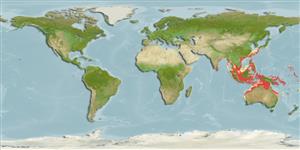Teleostei (teleosts) >
Anguilliformes (Eels and morays) >
Ophichthidae (Snake eels) > Ophichthinae
Etymology: Ophichthus: Greek, ophis = serpent + Greek, ichthys = fish (Ref. 45335).
More on author: Bleeker.
Environment: milieu / climate zone / depth range / distribution range
Ecology
Marine; brackish; demersal. Tropical
Indo-Pacific.
Size / Weight / Age
Maturity: Lm ? range ? - ? cm
Max length : 95.0 cm TL male/unsexed; (Ref. 12693)
Short description
Identification keys | Morphology | Morphometrics
Vertebrae: 197 - 199. Similar in to O. aphotistos in dorsal fin origin, above 16th vertebra and biserial dentition, but is more elongated and has more vertebrae, 197-199 (Ref. 40865).
Found in shallow water (Ref. 40865). Probably spends most of the day in a burrow along the river bank and forages actively at night for small fishes (Ref. 12693); in soft bottom (Ref. 7300).
Life cycle and mating behavior
Maturity | Reproduction | Spawning | Eggs | Fecundity | Larvae
McCosker, J.E. and Y.-Y. Chen, 2000. A new species of deepwater snake-eel, Ophichthus aphotistos, with comments on Neenchelys retropinna (Anguilliformes: Ophichthidae) from Taiwan. Ichthyol. Res. 47(4):353-357. (Ref. 40865)
IUCN Red List Status (Ref. 130435: Version 2024-1)
Threat to humans
Harmless
Human uses
Fisheries: of no interest
Tools
Special reports
Download XML
Internet sources
Estimates based on models
Preferred temperature (Ref.
123201): 24.2 - 29, mean 28 °C (based on 716 cells).
Phylogenetic diversity index (Ref.
82804): PD
50 = 0.5000 [Uniqueness, from 0.5 = low to 2.0 = high].
Bayesian length-weight: a=0.00091 (0.00039 - 0.00215), b=2.99 (2.79 - 3.19), in cm total length, based on LWR estimates for this (Sub)family-body shape (Ref.
93245).
Trophic level (Ref.
69278): 4.5 ±0.80 se; based on food items.
Resilience (Ref.
120179): Medium, minimum population doubling time 1.4 - 4.4 years (Preliminary K or Fecundity.).
Fishing Vulnerability (Ref.
59153): High vulnerability (58 of 100).
